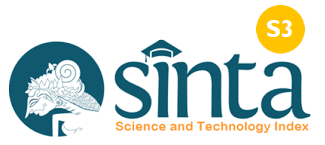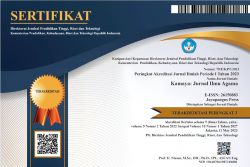Kasantikaning Raga Sebagai Teks Sastra-Rupa-Pertunjukan
Pengalihwahanaan Dan Kompleksitas Ideologi
DOI:
https://doi.org/10.37329/kamaya.v8i1.3901Keywords:
Kasantikaning Raga, Translation, Creativity, IdeologyAbstract
This paper will discuss the text of a puppet play entitled Kasantikaning Raga. The text that contains a narrative about the character Gathotkaca has elements such as text, narrative structure, illustrations, and ideology. Because the text comes from the popular tradition of the Yogyakarta puppetry region, the idiom of Yogyakarta-style puppetry language is very strong. The text can also be used as a guideline in shadow puppet performances. The illustrations show the visual richness of the puppeteer's creativity as a poet, composer, and creator of visual images of wayang. The literary aspect is shown in the narrative text. The text, which dates back to the early 20th century, shows a pattern of transfer from textual to visual, textual to performance and vice versa. To see these various layers of elements, a study of text, image and discourse is needed to achieve the expected results. Reflecting on the material object in the form of the play of the appearance of the wanda figure of Gathotkaca, an ideology related to the conquest of celestial phenomena is also found to be utilized as a means of achieving fertility in the area where the text production is located.
References
Danesi, M. (2004). Messages, Signs, and Meanings: A Basic Textbook in Semiotics and Communication. Toronto: Canadian Scholars’ Press.
Damono, S. D. (2012). Alih Wahana. Jakarta: Editum.
Faruk, H. T. (2001). Beyond Imagination: Sastra Mutakhir dan Ideologi. Yogyakarta: Gama Media.
Groenendael, C. L. (1987). The Dalang Behind the Wayang: The Role of the Surakarta and Yogyakarta Dalang in Indonesian-Javanese Society. Dordrecht: Foris.
Groenendael, V. M. C. van. (1987). Dalang Di Balik Wayang. Jakarta: Pustaka Utama Grafiti.
Haryanto, S. (2014). Simbol dan Mitos dalam Wayang Purwa. Yogyakarta: Ombak.
Johnson, M., & Lakoff, G. (2003). Metaphors We Live By. Chicago: University of Chicago Press.
Kövecses, Z. (2010). Metaphor. Oxford: Oxford University Press.
Kuntara Wiryamartana. (1991). Blencong Ketawang: Sastra dan Masyarakat Jawa Abad XIX. Yogyakarta: Gadjah Mada University Press.
Marianto, M. D. (2007). Relasi Luar-Dalam Antara Seni dan Metafora. Surya Seni: Jurnal Penciptaan dan Pengkajian Seni, 3(1). Yogyakarta: Program Pascasarjana ISI Yogyakarta.
Padmosoekotjo, S. (1960). Ngengrengan Kasusastran Djawa Djilid II. Jogjakarta: Hien Hoo Sing.
Panofsky, E. (1983). Meaning in the Visual Arts. Chicago: University of Chicago Press.
Poerwadarminta, W. J. S. (1939). Baoesastra Djawa. Batavia: J. B. Wolters’ Uitgevers Maatschappij N.V. Groeningen.
Pramutomo, S. (2010). Wayang dan Dinamika Budaya Jawa. Yogyakarta: Pustaka Pelajar.
Rahyono, F. X. (2009). Kearifan Budaya dalam Kata. Jakarta: Wedatama Widya Sastra.
Saputra, K. H. (2015). Panji Angreni: Keberpautan Kelisanan dengan Keberaksaraan. Disertasi. Depok: Fakultas Ilmu Pengetahuan Budaya, Program Studi Ilmu Susastra.
Soedarso, S. P. (2006). Trilogi Seni: Penciptaan, Eksistensi, dan Kegunaan Seni. Yogyakarta: Badan Penerbit ISI Yogyakarta.
Soedarsono, R. M. (1997). Wayang Wong: Drama Tari Ritual Kenegaraan di Kraton Yogyakarta. Yogyakarta: Gadjah Mada University Press.
Sumardjo, J. (2002). Wayang: Asal Usul, Filsafat, dan Masa Depannya. Bandung: Penerbit ITB.
Wolf, W. (2007). Description as a Transmedial Mode of Representation: General Features and Possibilities of Realization in Painting, Fiction, and Music. Dalam W. Wolf & W. Bernhart (Eds.), Description in Literature and Other Media. Amsterdam–New York: Rodopi.
Downloads
Published
How to Cite
Issue
Section
License
Copyright (c) 2025 Kamaya: Jurnal Ilmu Agama

This work is licensed under a Creative Commons Attribution-ShareAlike 4.0 International License.
An author who publishes in the Kamaya : Jurnal Ilmu Agama agrees to the following terms:
- Author retains the copyright and grants the journal the right of first publication of the work simultaneously licensed under the Creative Commons Attribution-ShareAlike 4.0 License that allows others to share the work with an acknowledgement of the work's authorship and initial publication in this journal
- Author is able to enter into separate, additional contractual arrangements for the non-exclusive distribution of the journal's published version of the work (e.g., post it to an institutional repository or publish it in a book) with the acknowledgement of its initial publication in this journal.
- Author is permitted and encouraged to post his/her work online (e.g., in institutional repositories or on their website) prior to and during the submission process, as it can lead to productive exchanges, as well as earlier and greater citation of the published work (See The Effect of Open Access).
Read more about the Creative Commons Attribution-ShareAlike 4.0 Licence here: https://creativecommons.org/licenses/by-sa/4.0/.





